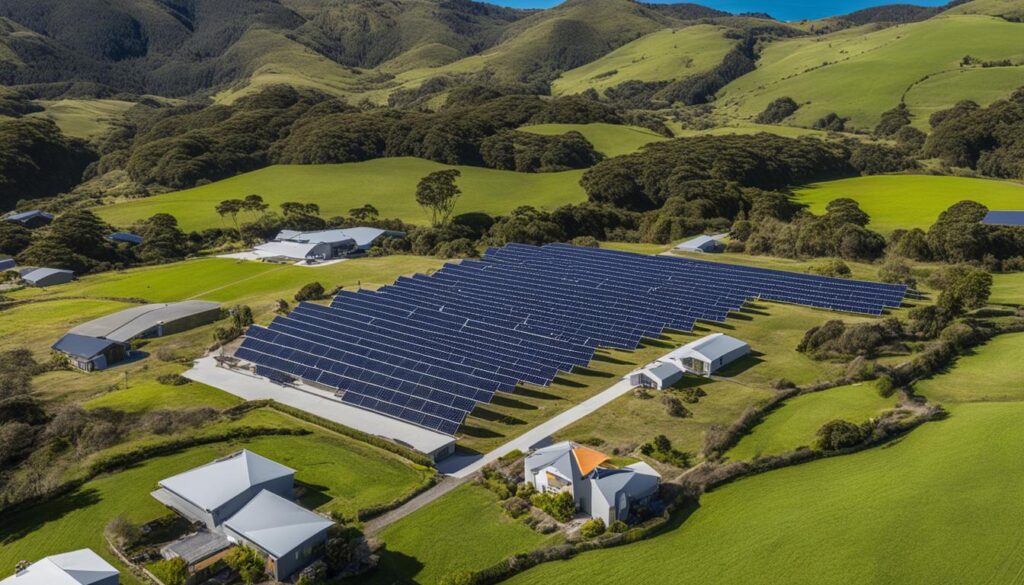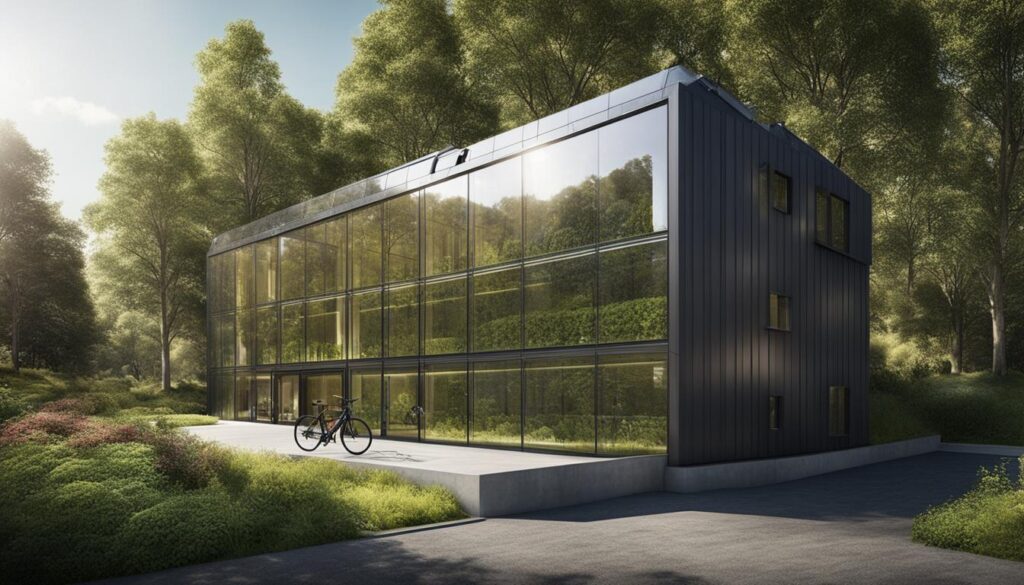G’day mates! Today, I’m here to talk about something close to my eco-warrior heart – Environmentally Sustainable Design (ESD) in Wellington Shire Council. This forward-thinking council is not just embracing sustainable building design, but it’s also paving the way for a greener future in the land Down Under.
Now, you might be wondering, what exactly is ESD? Well, it’s all about creating eco-friendly architecture that promotes sustainability and reduces the environmental impact of construction. And let me tell you, the Wellington Shire Council is leading the charge!
With an unwavering commitment to sustainability, the council is incorporating ESD principles into all its building projects. From energy-efficient structures to sustainable materials, they’re taking a proactive approach to address climate change and promote sustainable urban planning.
So, grab your reusable water bottle and let’s dive deeper into the benefits, initiatives, and collaborations that make Wellington Shire Council a shining beacon of environmental sustainability!
Key Takeaways:
- Wellington Shire Council is committed to environmentally sustainable design (ESD).
- ESD brings numerous benefits, including lower energy consumption and reduced operating costs.
- The council incorporates renewable energy systems and eco-friendly materials in its projects.
- Environmental sustainability is a top priority for Wellington Shire Council.
- The council actively collaborates with the community and stakeholders to promote ESD.
The Benefits of Environmentally Sustainable Design
Implementing environmentally sustainable design practices, also known as ESD, offers numerous advantages for Wellington Shire Council and the community. By embracing green building practices and energy-efficient design, the council can reduce energy consumption and lower long-term operating costs. Sustainable urban planning approaches further enhance the livability, resilience, and overall environmental friendliness of communities.
One of the key benefits of environmentally sustainable design is its potential to significantly reduce energy consumption. By incorporating energy-efficient features into buildings, such as passive cooling and heating systems, solar panels, and LED lighting, the council can maximize energy efficiency and minimize reliance on non-renewable energy sources. This not only reduces carbon emissions but also delivers substantial cost savings over the long term.
Another advantage of sustainable design practices is their contribution to sustainable urban planning. By creating communities that are more environmentally friendly, with ample green spaces, efficient transportation systems, and access to essential services, the council can improve the overall quality of life for residents. Sustainable urban planning also enhances the resilience of communities, making them better prepared to withstand environmental challenges, such as extreme weather events.
“Environmentally sustainable design brings a plethora of benefits, from reduced energy consumption to improved community livability.”
Moreover, environmentally sustainable design helps to preserve natural resources by promoting the use of sustainable materials. The council can leverage locally sourced materials, recycled materials, and low-impact construction techniques to minimize resource depletion and waste generation. By prioritizing sustainable materials in construction projects, the council can set an example for other municipalities and inspire a shift towards more sustainable practices in the construction industry.
| Benefits of Environmentally Sustainable Design |
|---|
| Reduces energy consumption and lowers operating costs |
| Improves community livability and resilience |
| Preserves natural resources by promoting sustainable materials |
 In conclusion, embracing environmentally sustainable design practices brings a multitude of benefits to Wellington Shire Council and the community. By implementing green building practices, energy-efficient design, and sustainable urban planning, the council can lower costs, improve quality of life, and contribute to a greener future.
In conclusion, embracing environmentally sustainable design practices brings a multitude of benefits to Wellington Shire Council and the community. By implementing green building practices, energy-efficient design, and sustainable urban planning, the council can lower costs, improve quality of life, and contribute to a greener future.
Sustainable Building Design Initiatives
When it comes to environmentally sustainable design, Wellington Shire Council is leading the way with its innovative initiatives in sustainable building design. By incorporating renewable energy systems and sustainable materials into their projects, the council is setting a new standard for eco-friendly construction.

One of the key initiatives implemented by the council is the integration of renewable energy systems. This includes the installation of solar panels and wind turbines in buildings to generate clean and renewable energy. By harnessing the power of nature, the council not only reduces its carbon footprint but also contributes to the overall energy independence of the shire.
In addition to renewable energy systems, the council also prioritizes the use of sustainable materials in its construction projects. This includes the sourcing of recycled or locally sourced materials, which helps to minimize resource depletion and waste generation. By promoting the use of sustainable materials, the council is not only reducing the environmental impact of construction but also supporting local businesses and communities.
In summary:
- Wellington Shire Council incorporates renewable energy systems in its construction projects, such as solar panels and wind turbines.
- The council focuses on using sustainable materials, including recycled or locally sourced materials, to reduce resource depletion and waste generation.
With these sustainable building design initiatives, the Wellington Shire Council is making a significant contribution to environmental sustainability in the shire. By embracing renewable energy systems and sustainable materials, the council is creating a greener and more sustainable future for the community.
Environmental Sustainability in Wellington Shire

When it comes to environmental sustainability, the Wellington Shire Council is leading the way in creating a greener future. The council’s commitment to environmentally friendly practices extends beyond their building projects and encompasses all aspects of their operations. By implementing initiatives that promote waste management and biodiversity conservation, the council aims to protect and preserve the natural resources and ecosystems within the shire.
One of the key areas where the council prioritizes environmental sustainability is in waste management. They have established comprehensive waste management initiatives that focus on reducing, reusing, and recycling waste. By encouraging residents and businesses to adopt sustainable waste management practices, the council aims to minimize landfill waste and promote a circular economy.
Table: Environmental Sustainability Initiatives
| Initiative | Description |
|---|---|
| Recycling Program | The council runs an extensive recycling program that includes the collection and processing of various recyclable materials, such as paper, plastic, glass, and metal. |
| Composting Facilities | Wellington Shire Council has established composting facilities where organic waste is processed to produce nutrient-rich compost for use in landscaping and agriculture. |
| Biodiversity Conservation | The council actively works to protect and enhance biodiversity within the shire, including the preservation of native flora and fauna habitats. |
Beyond waste management, the council also focuses on biodiversity conservation efforts. They understand the importance of preserving the natural ecosystems and habitats that contribute to the overall health and resilience of the shire. By implementing measures to protect and enhance biodiversity, such as habitat restoration and the control of invasive species, the council ensures the long-term sustainability of the shire’s natural environment.
In conclusion, the Wellington Shire Council’s commitment to environmental sustainability goes beyond the realm of building design. By prioritizing waste management and biodiversity conservation, the council is taking proactive steps to protect the natural resources and ecosystems within the shire. Their initiatives serve as a model for other municipalities looking to embrace sustainable practices and create a greener future for their communities.
Collaboration with Community and Stakeholders
When it comes to embracing environmentally sustainable design, collaboration with the community and stakeholders is crucial. It’s not just about the Wellington Shire Council implementing sustainable practices; it’s about engaging with the people who live and work in the shire, as well as other key stakeholders, to ensure that the initiatives align with their needs and priorities.
Community engagement plays a vital role in the success of environmentally sustainable design projects. By actively involving residents, businesses, and community groups in the decision-making process, the council fosters a sense of ownership and shared responsibility. This collaborative approach not only ensures that the implemented initiatives are effective and relevant but also creates a stronger sense of community connection and pride.
“We believe that the best outcomes are achieved when we work together,” says Jane Anderson, a community engagement officer at the Wellington Shire Council. “By seeking input and engaging in meaningful conversations with our community and stakeholders, we can make informed decisions that benefit everyone.”
“Collaboration is the key to success,” emphasizes John Dawson, a local business owner and member of the Wellington Shire Sustainability Alliance. “When the council actively involves us in their environmentally sustainable design projects, it strengthens our sense of commitment to sustainability and encourages us to become ambassadors for positive change within our businesses and communities.”
Through workshops, forums, and regular communication channels, the Wellington Shire Council ensures that the community and stakeholders have a voice in shaping the future of sustainable development in the shire. By fostering collaboration and actively listening to diverse perspectives, the council can create environmentally sustainable designs that truly reflect the needs and aspirations of the community.
Key Benefits of Collaboration:
- Improved project outcomes that align with community values and priorities.
- Enhanced sense of ownership and shared responsibility among community members.
- Increased community engagement and participation in sustainable initiatives.
- Creation of a network of sustainability advocates within the community.
Stakeholder Collaboration:
| Stakeholder Group | Role |
|---|---|
| Residents | Provide input on community needs and preferences. |
| Businesses | Offer insights on sustainable practices and implementation strategies. |
| Community Groups | Advocate for sustainability initiatives and support community engagement efforts. |
Case Studies of ESD Projects in Wellington Shire
I’m excited to share with you some inspiring case studies of environmentally sustainable design (ESD) projects implemented by the Wellington Shire Council. These projects serve as exemplars of sustainable design practices and initiatives, showcasing the council’s commitment to creating a greener and more sustainable future.
One notable ESD project undertaken by the council is the construction of an energy-efficient community center. This facility incorporates green building practices such as solar panels, energy-efficient lighting, and rainwater harvesting systems. By utilizing renewable energy sources and implementing sustainable technologies, the community center significantly reduces its carbon footprint and sets an example for sustainable building design in the shire.
“The Wellington Shire Council’s commitment to environmentally sustainable design is commendable. The energy-efficient community center stands as a testament to their dedication to reducing environmental impact while providing essential infrastructure to the community.” – Local resident
Another noteworthy ESD initiative is the development of green infrastructure and sustainable transport solutions in the shire. The council has implemented a network of bike lanes and pedestrian-friendly pathways, promoting active and sustainable modes of transportation. Additionally, the incorporation of green spaces and vegetation in urban planning enhances biodiversity, improves air quality, and creates more livable and resilient communities.
| ESD Project | Description | Sustainability Impact |
|---|---|---|
| Energy-efficient community center | Incorporates solar panels, energy-efficient lighting, and rainwater harvesting systems | Significantly reduces carbon footprint, serves as a model for sustainable building design |
| Green infrastructure and sustainable transport | Development of bike lanes, pedestrian-friendly pathways, and incorporation of green spaces | Promotes active and sustainable modes of transportation, improves air quality, enhances biodiversity |
| Rainwater harvesting systems | Integration of rainwater collection systems in public buildings | Reduces reliance on mains water supply, conserves water resources |
Furthermore, the council has implemented rainwater harvesting systems in public buildings, such as libraries and recreational facilities. These systems collect and store rainwater for non-potable uses, reducing the reliance on mains water supply and conserving water resources. This initiative not only contributes to water sustainability but also raises awareness among the community about the importance of responsible water usage.
Through these case studies, the Wellington Shire Council demonstrates its commitment to sustainable development and showcases the positive impacts of ESD projects. By integrating sustainable design principles into their projects and promoting environmentally friendly practices, the council sets an example for other municipalities and creates a more sustainable and resilient community.

Building Awareness and Education
In order to foster a greener future, the Wellington Shire Council prioritizes building awareness and education around environmentally sustainable design. Through sustainability education programs and awareness campaigns, the council aims to engage the community and promote sustainable behaviors. These initiatives are crucial in empowering individuals and businesses to make environmentally conscious choices and contribute to a more sustainable world.
One of the key aspects of sustainability education is spreading knowledge about the importance of environmentally sustainable design practices. By educating the community about the benefits of sustainable building design, energy-efficient practices, and the use of sustainable materials, the council can inspire individuals to adopt sustainable behaviors in their own lives and support eco-friendly initiatives.
Furthermore, the council’s awareness programs play a vital role in encouraging active participation and engagement. By organizing workshops, seminars, and public events, the council creates platforms for community members to learn and share their own ideas and experiences. These events provide opportunities for individuals to connect with like-minded individuals and promote a sense of collective responsibility towards sustainability.
Through its commitment to building awareness and education, the Wellington Shire Council is inspiring positive change in the community. By equipping individuals with the knowledge and tools to embrace environmentally sustainable design, the council is paving the way for a greener and more sustainable future.
Benefits of Sustainability Education and Awareness Programs
The council’s sustainability education and awareness programs yield several benefits. Firstly, they empower individuals to make informed choices that positively impact the environment. By raising awareness about sustainable practices, individuals can adopt eco-friendly habits in their daily lives, such as reducing energy consumption, minimizing waste generation, and making conscious choices about transportation.
Secondly, these programs foster a sense of shared responsibility and community engagement. By bringing together residents, businesses, and community groups, the council encourages collaboration and collective action towards sustainability goals. This not only strengthens the community’s resilience but also enhances the overall quality of life in the Wellington Shire.
Lastly, sustainability education and awareness programs create a ripple effect of positive change. When individuals are educated about the importance of sustainable design, they become advocates for these practices in their own circles. This leads to a multiplier effect, where knowledge and awareness spread organically, creating a more environmentally conscious and sustainable community.
Monitoring and Evaluation of ESD Initiatives
As the Wellington Shire Council continues its commitment to environmentally sustainable design (ESD), diligent monitoring and evaluation play a crucial role in assessing the effectiveness of implemented measures. By tracking sustainability performance indicators, the council gains valuable insights into the impact of ESD initiatives and identifies areas for improvement.
One key sustainability performance indicator is energy consumption. By measuring and analyzing energy usage in ESD projects, the council can identify opportunities for further energy efficiency improvements. This data-driven approach allows for evidence-based decision-making and ensures that the council’s efforts align with its sustainability goals.
| Indicator | Measurement | Objective |
|---|---|---|
| Energy Consumption | Monthly tracking of energy usage in ESD projects | Reduce energy consumption by 20% compared to conventional buildings |
| Water Usage | Monitoring water consumption in ESD projects | Minimize water usage through efficient plumbing systems and water-saving practices |
| Waste Generation | Regular assessment of waste generation in ESD projects | Implement waste reduction strategies and promote recycling and composting |
In addition to energy consumption, monitoring water usage is another crucial aspect of evaluating ESD initiatives. By closely tracking water consumption in ESD projects, the council can identify potential water-saving opportunities and implement efficient plumbing systems to minimize water usage. This focus on sustainable water management contributes to the conservation of this valuable resource.
Waste generation is also a significant sustainability performance indicator. Regular assessments of waste generation in ESD projects allow the council to implement waste reduction strategies and promote recycling and composting. By minimizing waste and diverting it from landfills, the council contributes to a circular economy and reduces the environmental impact of construction activities.
I believe that effective monitoring and evaluation are essential for successful ESD initiatives. By regularly assessing sustainability performance indicators, the Wellington Shire Council can ensure that its efforts are yielding tangible results and driving meaningful change. The data collected through monitoring and evaluation not only allows the council to make informed decisions but also serves as a powerful tool for educating and inspiring other communities to embrace environmentally sustainable design.
Government Support for ESD in Wellington Shire
When it comes to embracing environmentally sustainable design (ESD), the Wellington Shire Council is not alone in its endeavors. The council receives crucial government funding and policy support to further promote and implement ESD initiatives throughout the region. This support strengthens the council’s commitment to environmental sustainability and enables them to make a significant impact on the local community.
By collaborating with state and federal government agencies, the Wellington Shire Council gains access to valuable resources, funding opportunities, and policy frameworks that facilitate the integration of sustainable design practices. This support goes a long way in facilitating the council’s mission to create eco-friendly, energy-efficient structures that reduce the environmental impact of construction and address climate change.
Through government funding, the council can invest in innovative technologies, renewable energy systems, and sustainable materials. These investments not only contribute to the council’s sustainability goals but also serve as tangible examples for the community and other municipalities to follow. With the support of government policies, the council can navigate regulatory frameworks and implement sustainable practices effectively.
| Government Support for ESD in Wellington Shire | Benefits |
|---|---|
| Government funding | Enables investment in sustainable technologies and materials |
| Policy support | Facilitates the integration of sustainable design practices |
| Access to resources | Provides valuable knowledge and expertise for sustainable development |
I believe that the government’s commitment to supporting environmentally sustainable design in Wellington Shire is a testament to their recognition of the importance of sustainable development. Through their financial backing and policy support, the government is not only contributing to the council’s efforts but also setting a precedent for other regions to prioritize sustainability. Together, we can create a greener future for our community and generations to come. – Mayor of Wellington Shire
Conclusion
Ah, the sweet smell of success! Wellington Shire Council has truly embraced environmentally sustainable design, and the results speak for themselves. With an unwavering commitment to a greener future, the council has set a shining example for other municipalities.
Through their dedication to sustainable building design, the Wellington Shire Council is not only reducing their environmental impact but also saving some serious cash in the long run. By incorporating energy-efficient practices and sustainable materials, they are paving the way for a more eco-friendly and financially savvy approach to construction.
But it doesn’t stop there! The council understands the power of community engagement and stakeholder collaboration. By involving residents, businesses, and community groups in their decision-making process, the council ensures that their sustainable practices align with the needs and values of the people they serve. Talk about a win-win!
With their impressive portfolio of ESD projects, Wellington Shire Council proves that sustainable design is not just a fantasy—it’s a reality. From energy-efficient buildings to green infrastructure and sustainable transport initiatives, the council is leading the charge towards a more sustainable and resilient community.
FAQ
What is environmentally sustainable design (ESD)?
Environmentally sustainable design refers to the practice of incorporating eco-friendly and energy-efficient principles into building projects to reduce environmental impact and promote sustainability.
How does Wellington Shire Council implement ESD in its projects?
Wellington Shire Council incorporates various sustainable building design initiatives, including the integration of renewable energy systems and the use of sustainable materials, to promote environmental sustainability.
What are the benefits of environmentally sustainable design?
Embracing ESD brings benefits such as reduced energy consumption, lower operating costs, sustainable urban planning, and the creation of more livable and environmentally friendly communities.
How does Wellington Shire Council collaborate with the community and stakeholders in promoting ESD?
The council actively engages with residents, businesses, and community groups to gather input and ensure that sustainable practices align with the needs and values of the community.
Can you provide examples of ESD projects implemented by Wellington Shire Council?
Yes, examples include energy-efficient buildings, green infrastructure, and sustainable transport initiatives that showcase sustainable design practices and provide valuable lessons for future developments.
How does Wellington Shire Council promote awareness and education around ESD?
The council conducts sustainability education programs and awareness campaigns to engage the community and promote sustainable behaviors, empowering individuals and businesses to make environmentally conscious choices.
How does Wellington Shire Council monitor and evaluate the performance of its ESD initiatives?
The council tracks sustainability performance indicators such as energy consumption, water usage, and waste generation to assess the effectiveness of implemented measures and identify areas for improvement.
Does Wellington Shire Council receive government support for its ESD initiatives?
Yes, the council collaborates with state and federal government agencies to access resources, funding opportunities, and policy frameworks that facilitate the integration of sustainable design practices.
What is the main goal of Wellington Shire Council’s embrace of environmentally sustainable design?
The council’s main goal is to create a greener future by addressing climate change, promoting sustainable development, and contributing to a more sustainable and resilient community.
Source Links
- https://researchdirect.westernsydney.edu.au/islandora/object/uws:22669/datastream/PDF/view
- https://www.earlychildhoodaustralia.org.au/wp-content/uploads/2014/05/Final-Report-Environmental-Education-in-Early-Childhood-public-version….pdf
- https://s3.ap-southeast-2.amazonaws.com/dpe-files-production/s3fs-public/dpp/297764/Attachment 13 – ESD Study.pdf
